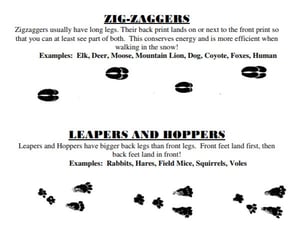 Looking for something to do with the kids this summer? How about a lesson on animal prints and track patterns? This is an activity-based learning experience that you can do right in your own backyard so get out there and have some fun!
Looking for something to do with the kids this summer? How about a lesson on animal prints and track patterns? This is an activity-based learning experience that you can do right in your own backyard so get out there and have some fun!
Objective of Lesson:
To understand how to identify animal prints and track patterns.
Age Group:
Any
Time:
30-60 minutes
Engage:
Do we see a lot of animals when we are outside? (No)
How do we know that they are out here? (We see signs of them)
What is some evidence that they are here?
- browsing
- tracks
- scat
- claw marks
- burrows/homes
- feathers
- hair
- carrion
- blood
- food cache
- odor
- urine
- bedding
- we actually see them
Explore:
Look for signs of animals.
Explain:
Even though we may not see them, there are a lot of way we can know that they are here. Once we see these signs, we can begin to identify them.
PRINTS – one single print
Prints can be split up into 3 groups depending on the foot structure of the animal:
PLANTAGRADE
- Heel and Toe
- Humans, primates, bears
DIGITIGRADE
- Balls of feet; Paw prints
- Coyote, Fox, Dog, Cat , Squirrels, Hare, Rabbits
UNGULAGRADE
- Walking on toenails; no pad
- Elk, Deer, Moose, Sheep
TRACKS AND PATTERNS
A track is a pattern left by a series of prints.
Please note: Patterns are not scientific or definite; animals can fit into different pattern types depending on how they are walking or running.
Illustration: Animal_Tracks
Elaborate:
What else should you look at when attempting to identify an animal print or track pattern?
- Where it goes/comes from
- Look at the habitat location and range
- Look at the depth of the print in the snow (will give you an idea of weight)
Evaluate:
Have students identify track patterns that they find.
How was your experience? We'd love to hear your comments, what did the kids enjoy or how did you modify the lesson plan to create excitement around the topic?
Stay Connected! Sign up to receive Walking Mountains news by email








